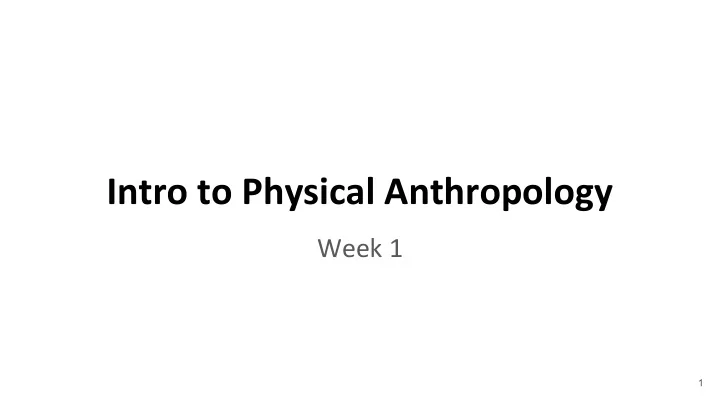

Intro to Physical Anthropology Week 1 1
Summary -introduce: course website, me, key terms -exercise -class overview (syllabus redtape) -overview of anthropology and physical anthropology 2
Course website https://creason.co/ CANVAS also updated Very important for this class -Syllabus -Assignment instructions -Sample essays, tests, and questions -Study guides 3
Course website and personal Prof Creason Transferred from LBCC BA in anthropology from UCLA MA in anthropology from CSUN Focus: paleoanthropology Interests: paleopathology and archaeology of war 4
Important terms to learn anthropology Evolution: change in the genetic structure of a population over time Adaptation: response of an organism or a population to the environment. -the result of evolutionary change 5
Important terms to learn anthropology Hominins: taxonomic group that includes Homo sapiens and their extinct bipedal relatives. Anthropology: the study of hominins Obviously much more... 6
First day exercise Question: what makes humans unique? Adaptation: evolutionary responses to the environment. Answer: Humans use culture as an adaptive strategy. -highly social -flexible, learned -non-genetically transmitted 7
Physical anthropologists: study human biology and behavior in an evolutionary context. Culture: complex set of behaviors 8
Syllabus redtape Required Text: Jurmain R, Kilgore L, & W Trevathan. 2016. Essentials of Physical Anthropology . (10th edition). Belmont, CA: Wadsworth/Thomson Learning. First chapter is available on Google Books. 9
Anthropology: the field of inquiry that studies human culture and the evolutionary aspects of human biology. Anthropology in the US has four main subfields: cultural anthropology linguistic anthropology archaeology physical anthropology 10
Cultural anthropology Cultural anthropologists study patterns of belief and behavior found in modern and historic societies Ethnographies: descriptive studies of human societies Culture: learned behaviors transmitted over generations non-genetically 11
Linguistic anthropology Linguistic anthropologists: study the interactions between speech, language, and culture (e.g., role of symbols in society). -compare/contrast modern languages to trace their historical ties -language is uniquely human 12
Archaeology Archaeologists: study the material remains of past societies -analyze artifacts: objects made or modified for use by hominins - excavate in order to gain info about human behavior 13
Physical anthropology Physical anthropologists: study human biology and behavior in an evolutionary context -explain variation in human adaptations AKA biological anthropology -'biological' reflects modern shift towards using genetics, evolutionary biology, etc. 14
Subfields of physical anthropology Primatologists: study nonhuman primate biology and behavior -use the comparative approach 15
Subfields of physical anthropology Paleoanthropologists: study hominin anatomical and behavioral evolution in the fossil record. -reconstruct our ancestors' adaptations and behaviors Osteology: the study of skeleton structure and function 16
Subfields of physical anthropology Paleopathology: studies incidence of trauma, disease, nutritional deficiency, and other traces of pathology evident on human remains in the fossil record. 17
Subfields of physical anthropology Forensic anthropologists: apply archaeological and osteological techniques to legal matters -identify and analyze skeletal remains that have legal significance 18
Applied anthropology: practical application of anthropological and archaeological theories and techniques 19
Physical anthropology Biocultural evolution: mutual, interactive evolution of human biology and culture -behavioral aspects of human adaptation E.g., technology, traditions, language, marriage patterns, social roles, etc. 20
Recommend
More recommend